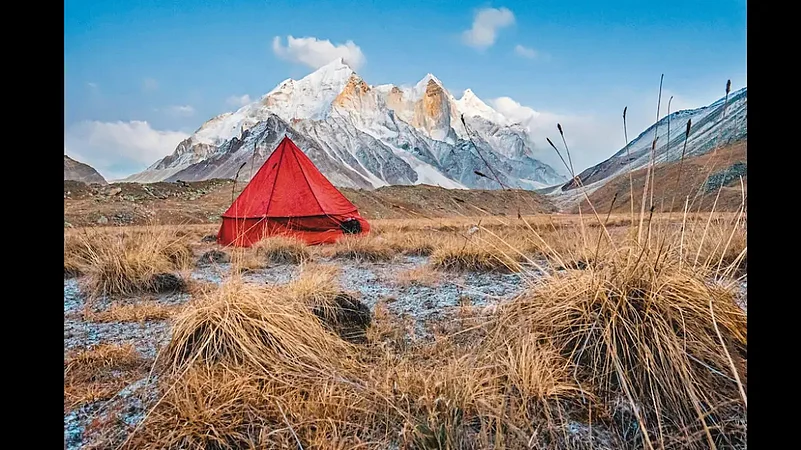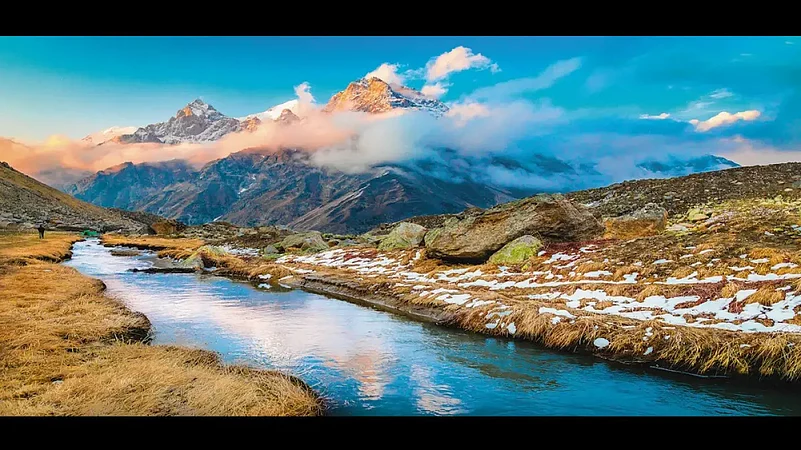Your house is your Gulag — that’s what the pandemic did to us since March 2020, keeping us indoors, and redefining our interpersonal relationships to the extent that the season’s greeting became “stay safe and stay away”. From the crowd that is. But calls of the hiking boots swelled like the monsoon clouds, waiting impatiently to dunk all below. By autumn 2020, it was impossible for me and my girlfriend, Mallika, to not heed the call — of the mountains or the jungle or someplace other than Delhi. The long lockdown had ended, COVID cases were declining, and Uttarakhand offered a window. We knew we had to go. Now, COVID hasn’t entirely gone away and the protocols such as social distancing and avoiding crowded spaces were very much there. Our travel plan must agree with the rules and so we cottoned onto the idea of going deep into the Himalayas and giving our pins their long-pined-for exercise. Of all the options, trekking ticked the most boxes. And why not? A solitary walk in the woods is perhaps the perfect pandemic activity, tailor-made for social distancing. Even a guided trekking tour on popular trails up there is a lot safer than travelling in a city. Besides, it brings much-needed money to remote communities dependent on tourism, which is ravaged by the pandemic. There couldn’t have been a better time to explore and enjoy solitude.
In October 2020, Mallika and I visited Gangotri for two separate three-day treks. The first took us to Gomukh, a source of the Ganga at the yawning mouth of the Gangotri glacier, and then to the stunning Tapovan meadow. Returning to town, we set off for the second hike to the awe-inspiring lake of Kedartal. Easy access to these high mountains is a lucky byproduct of military activity and the flood of religious pilgrims to Gangotri. A trekker can drive on a paved road to Gangotri, at 3,100 m, and hike in a single day to the foot of the mountains above 6,000 m. Few places in the world offer such powerful mountains so accessibly. The mountains of Gangotri have a deep-seated spirituality.

The Road to Gangotri
Mallika and I got our PCR tests and hopped on a flight from Delhi to Dehradun. A taxi took us up the long, spectacular route into the Himalayas, through Uttarkashi to Gangotri. The unending ridges were hypnotic, full of hill villages and terraced fields. We bought fresh local fruits and vegetables as snacks. By the time we reached Gangotri, darkness and cold had enveloped the land. Dawn revealed Gangotri as a stunning town squeezed between vertically forested ridges, above the glacial Bhagirathi river. We finalised our permits, hired local guide Rakesh Rao and hit the trail on our first hike to Gomukh.
Hike1: To Gomukh and Tapovan
The trail climbed into a picturesque valley bursting in all pigments of colour. Autumn has touched the land, painting the leaves orange and gold. The Bhagirathi raged milky-blue through chaotically strewn boulders, below textured granite slopes. Rugged wooden bridges lay high across streams. When the stunning pyramid of Bhagirathi peak appeared in the afternoon, we used its snowy promises to pull us forward as the challenge of altitude increased. We planned to sleep at the 3,775-m-high Bhojwasa camp, but had not yet acclimatised. Our packs felt like lead. Only a herd of wild bharal, Himalayan blue sheep, provided some relief from the uphill grind. Finally, we crested a ridge to a view beyond belief: the whole Bhagirathi mountain in front of us, immense yet graceful, catching the orange glow of the setting sun on its snowy summit. Before dawn, we were hanging in a welded metal box on a cable above the roaring Bhagirathi. We were the first to cross that morning. The trail continued up the widening valley, arriving in a tremendous boulder-field. This brutal no man’s land, left behind by the glacier retreating at 25 m a year, made for a surreal hike.
Tapovan and the Mouni Baba
The glacier’s famous mouth loomed ahead at Gomukh. Instead of visiting it right away, we scrambled up a rocky slope to the high meadow called Tapovan. It lies far above the great buckling form of the glacier, right at the foot of stupendous summits. We pulled ourselves over the last boulders onto Tapovan and saw a full panorama of rock and ice. The beauty of Mount Shivling smacked us in the face as its perfectly proportioned ridges sliced into the sky above 6,500 m.

We continued to the small, rock-built ashram that houses Tapovan’s lone hermit — Mouni Baba, the quiet one, because he took a decade-long vow of silence. He has lived alone in this remote abode for 14 years. He is proof of willpower, enduring through the winters at such an altitude. Luckily, Mouni Baba has opened up to the world. He was happy to receive us, and we found him surprisingly young, witty, and urbane. His voice was barely audible, but the glint in his eye exuded warmth. When Mallika told him that she had grown up in Bombay but now lived in Delhi, he joked about the idiocy of such a manoeuvre. He was happy to hear an unending flow of town gossip from Rakesh. The time at Tapovan was golden. We wandered the gentle meadow, took in the spectacular peaks from every angle, and noshed down tasty dal served by the Baba.
The Holy Water of Gomukh
With night approaching, we scrambled back down the boulder slope to Gomukh. The cave lived up to its name, looking like a yawning mouth dropping chunks of ice the size of tennis balls. Mallika scooped up some sacred water to bring back to her grandparents. It is fascinating to realise that the Ganga, central to the lives of so many people, begins right here. The walk back down to Gangotri town the next day felt like a victory lap. The October weather delivered, and we cruised under deep blue skies.
We were much more used to the altitude than the groups coming up the trail towards us. Some were geared-up trekkers, but others were families in jeans and with walking sticks. It was inspiring to see people of different ages and fitness levels pushing themselves higher and higher. Each minute of the hike demonstrated why we go through the efforts of permits, transport, and planning to reach such heights: a glorious combination of natural beauty, physical health, and the satisfaction of a goal well achieved. After so many months indoors in Delhi, this was utter bliss. We coasted into town with sore feet and high spirits.
Hike 2: To Kedartal Lake
The next hike promised different challenges than the route up to Gomukh and Tapovan. The goal was a legendary lake called Kedartal, in a steep, narrow, and wild valley above Gangotri town. There are no pilgrims or lodges, and only a few places flat enough even to pitch a tent. The route started aggressively, switchbacking up a near-vertical pine forest. We were well acclimatised from the first hike, though, and churned uphill easily. With the steepest part behind us, we fell into a smooth rhythm through stunning, healthy forests and waterfalls. The wild aspect of this trail unfolded with scrambles across rocky slopes.

As we lugged our packs up the valley, Rakesh told us stories from his village in the Garhwal region. He said, before 1991, few people in the village had seen money. His family used only two jugs of water a day because they had to walk long down to the river to collect it. In 1991, the combination of economic liberalisation and a disastrous earthquake transformed the village. The quake destroyed most houses, but families received a government payout to rebuild. That improved lives. He said people now keep their cows in buildings better than their own houses in 1991. By late afternoon, we broke through the last trees into a sloping scrubland above 13,000 feet. The autumn’s paintbrush on grasses and flowers made every patch of ground complex and beautiful.
The massive form of Mount Thalay Sagar muscled into view. The highest mountain of the trip at 6,904 m, its conical form and snow-capped snout made it look like a massive spaceship ready to take off. Walking right towards the spaceship, with clouds swirling around it like exhaust fumes, it felt like humanity had selected us for a mission to the stars. We were taking our final walk on our native Earth. And what a walk it was: the valley ridges were topped with sharp spires, the glacial river rushed far below, and green life strived through every crack in the rock. We reached camp dog tired from the heavy packs and relentless uphill. Camp was a small platform on a steep hill, utterly exposed, but with spectacular mountain views in every direction. Light flakes announced a snowstorm as we closed the tents for the night.
The Indescribable Wonder of Kedartal
The air was crystal clear when we opened the tents the next morning, revealing Thalay Sagar in all its glory. We soon passed through a rockfall zone, the trail’s most dangerous section, where a rogue boulder could mean disaster. We moved quickly, and got through fine. Thanking the mountain gods, we ascended to a meadow at 4,400 m, then a tortuous boulder field. Each step required jumping from rock to rock, aiming for the stable ones. Progress was slow but we strained forward to the dream of Kedartal. We crested a final ridge and there it was. Even among the long list of impressive mountain lakes, Kedartal stands alone. It is marvelously deep blue, and sits right at the base of sheer cliffs that top out 2,000 m above. The lake’s soft curves provide a stunning contrast to the harsh rock and ice all around. Seeing this with our own eyes made the whole trip easily worth it. Perfect afternoon lighting highlighted the complexity of the Himalayan landscape, with deep ridges and fissures spreading through the rocks like braided rivers through sand.
Down to the Lowlands

We made it back to camp in time for a dazzling sunset on the immense form of Thalay Sagar. The snow peak turned gold, then pink, then a deep purple. We marvelled at it endlessly as the air chilled and cleared, seeming to bring the mountain closer and closer. Far better entertainment than any TV show can provide. The last day on the trail flew by, all downhill. Lower altitude, and the fragrant pine and birch forests, brought a feeling of easy contentment. We reached Gangotri, and said goodbye to the gorgeous pilgrimage town with its shops full of brass urns for Gomukh water. The local autumn rhythms entertained us on the long drive down. At Dharali village, famous for its orchards, succulent apples overflowed the tables of street-side markets. Past Harsil, a rowdy flock of sheep flowed like a river down the road, making their yearly migration downhill. We reached Uttarkashi in the dark and saw the lights of at least seven different weddings strung out across the hills. Dusshera had coincided with the relaxing of COVID restrictions to allow these joyous gatherings. After a week in the wild, it was deeply comforting to return to a panorama of human happiness, strung out in flashing bulbs and blasting music down the valley. It was clear that the pandemic had not wiped out the hill country’s unique charms. The trek had proved good medicine for our lockdown blues, and we vowed to hit a new trail every single year.
















